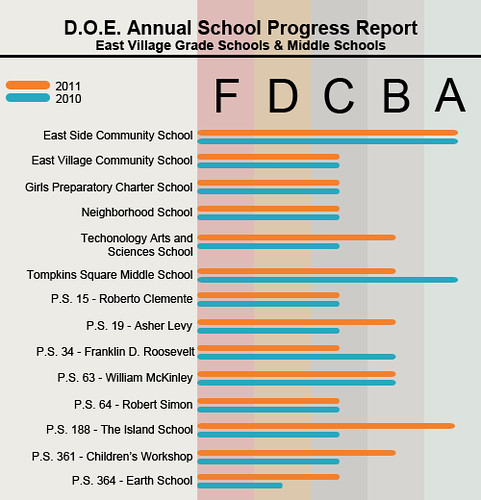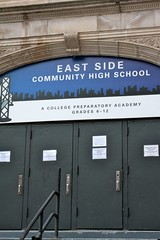Last week, as SchoolBook reported, the Department of Education issued its annual Progress Report for grade schools and middle schools (high school results will be issued next month). Due in part to changes in grading methods, double the number of schools — 10 percent — received failing grades of Ds and Fs. In the East Village, however, many schools held steady or raised their grades from last year, with the majority receiving Bs or Cs.
Seven of the report’s 15 East Village elementary and middle schools received Cs. Five earned Bs, with only East Side Community School and The Island School receiving top marks. Unlike last year, when Earth School received a D, no school was smacked with a D or F. Asher Levy, The Children’s Workshop School, and the Technology Arts and Sciences Studio School all bumped their scores up from a C to a B, and The Island School moved all the way up to A. Meanwhile, two schools were downgraded by a grade: Franklin D. Roosevelt to a C and Tompkins Square Middle School to a B.
Reached last week, before the department’s announcement, East Side’s principal Mark Federman was optimistic about the report. “I’m confident about getting an A this year, and even next year,” Mr. Federman said. “These are strong teachers and a strong community. We’ve been doing this for a long time – the staff has been stable for a long time. But there’s always room for improvement.”
Citywide, 25 percent of schools were given As, 35 percent received Bs, and 30 percent received Cs. Failing marks can result in administrative shakeups or even closure of a school, as was the case for Ross Global Academy on East 12th Street, which shut its doors in February.
The Department of Education assigns grades using a complicated methodology that measures school environment, student performance and student progress. Student scores on math and reading tests weigh heavily in the city’s calculations. This year, changes to the formula included a curve that gave Fs or Ds to ten percent of schools (last year, only 4.7 percent of schools received bottom marks), and the elimination of a virtual safety net that prevented schools from falling more than two grades a year.
“Good schools, even before the Progress Report [is announced] know what they need to do,” Mr. Federman said. “But the report does always make you pay attention — my feeling is the more data the better; you can’t have too much info.”
For more on the citywide results, see SchoolBook’s data mining.





